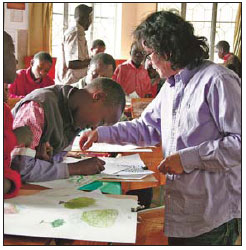Life
Drawing from life
By Xu Lin (China Daily)
Updated: 2011-01-10 08:08
 |
Large Medium Small |
|
Xu Bing teaches students at a primary school in the Mount Kenya National Park how to paint. Provided to China Daily |
It was while in Kenya that Xu Bing, 56, one of the nation's foremost contemporary artists hit upon a novel idea to save endangered forests.
And now, the vice-president of the China Central Academy of Fine Arts, hopes to replicate the success of that project in China. The project, started five years ago, trains local primary school students to draw pictures of trees and sell them, with the money raised being used to plant trees.
"Such a project could be very successful in China as parents are very supportive of their kids' activities," Xu says. The Kenya project is part of a program titled Human/Nature: Artists Respond to a Changing Planet which aims to use contemporary art to enhance people's awareness of conservation.
It was started in 2005 by the University of California, Berkeley Art Museum and Pacific Film Archive, the Museum of Contemporary Art San Diego, and the international conservation organization, Rare.
Xu was one of eight world-renowned artists selected by the program to go to countries with UNESCO-designated World Heritage sites.
Fascinated by wildlife, Xu chose Kenya. However, when he arrived in 2005, he found that deforestation was driving many species to extinction.
"I began to think about how to tackle deforestation," he says.
He was shocked to discover that Kenyan environment groups had been financially dependent on the West for hundreds of years.
He realized that raising funds that were self-sustainable was an urgent necessity.
That's when the idea of making money from art struck him. Xu designed a five-page textbook for kids aged 6 to 12, teaching them how to use ancient hieroglyphics and cuneiform symbols to visualize trees.
"I used the Internet to promote the idea," he says.
He uploaded the book online in 2008 and later visited a primary school located in the Mount Kenya National Park to teach the kids drawing. That triggered a lot of excitement, as many of the children found themselves holding crayons for the first time in their lives.
"I only gave them simple examples of how to use the symbols, and rarely guided them," Xu says.
Some came up with trees covered in flowers and fruits represented by letters and symbols. Most of the kids were at a loss as to how to draw a tree to begin with, but once they latched on to an idea, they stayed with it.
"It is difficult to explain their imagination, but their works are a feast for the eyes," Xu says.
He says the diversity of Kenya's flora explains the amazing variety of the drawings created by the kids.
"Art and its aesthetic spring from life," he says.
The artist has carefully copied all these drawings to make a big landscape painting of a forest.
All the pictures are displayed in an online exhibition on forestproject.net and can be bought for prices ranging from $25 to $100, through auction and sale. The money raised goes directly to the Bill Woodley Mount Kenya Trust, a Kenya-based organization dedicated to preserving local forests.
"While $2 is just enough for a subway ticket in the United States, it can be converted into 10 newly planted seedlings in Kenya," Xu says.
He says he has already sought sponsors in Beijing, Shenzhen and Hong Kong for a similar project in China. "But most corporations and foundations want to make it a business project," he says. "I want it to be an independent and non-profit one."
He is also afraid the drawings by Chinese kids may not show the same creativity as the Kenyans as they study in a relatively more rigid education system.
